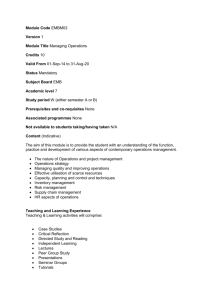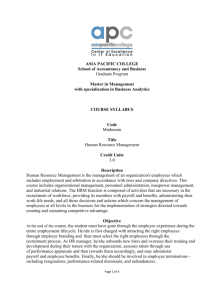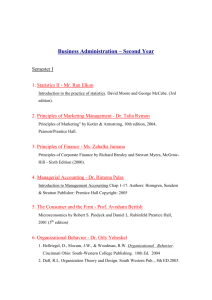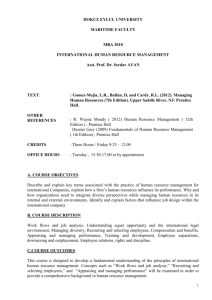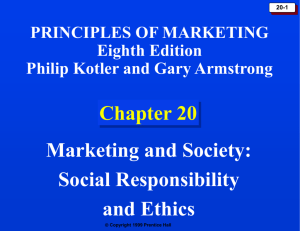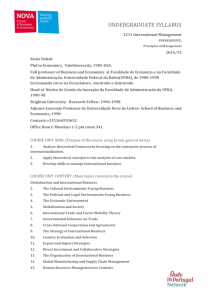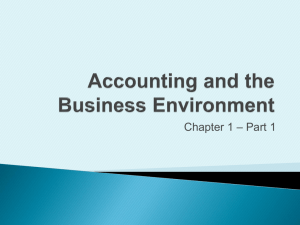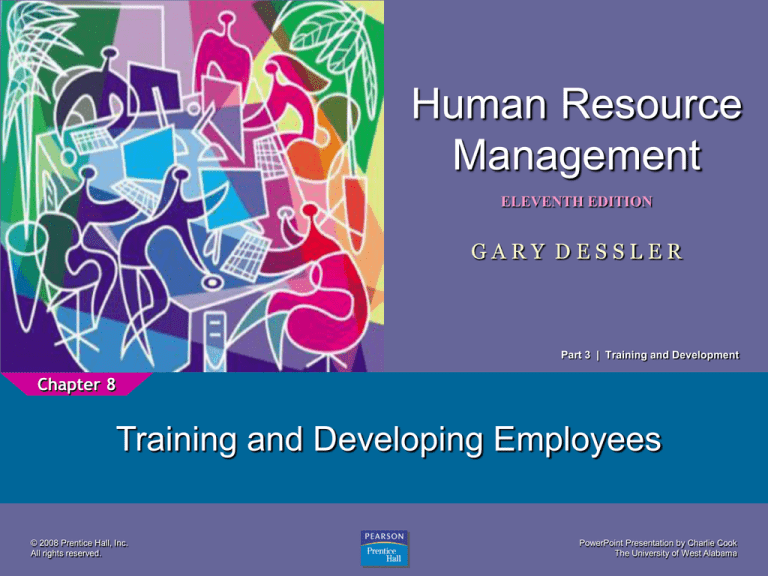
Human Resource
Management
ELEVENTH EDITION
1
GARY DESSLER
Part 3 | Training and Development
Chapter 8
Training and Developing Employees
© 2008 Prentice Hall, Inc.
All rights reserved.
PowerPoint Presentation by Charlie Cook
The University of West Alabama
After studying this chapter, you should be able to:
1. Describe the basic training process.
2. Describe and illustrate how you would go about
identifying training requirements.
3. Explain how to distinguish between problems you can
fix with training and those you can’t.
4. Explain how to use five training techniques.
© 2008 Prentice Hall, Inc. All rights reserved.
8–2
Purpose of Orientation
Orientation Helps
New Employees
Feel
Welcome
and At Ease
Understand
the
Organization
© 2008 Prentice Hall, Inc. All rights reserved.
Know What
Is Expected
in Work and
Behavior
Begin the
Socialization
Process
8–3
The Orientation Process
Company
Organization and
Operations
Employee Benefit
Information
Personnel
Policies
Daily
Routine
© 2008 Prentice Hall, Inc. All rights reserved.
Employee
Orientation
Safety Measures
and Regulations
Facilities
Tour
8–4
FIGURE 8–1
New Employee
Departmental
Orientation
Checklist
Source: UCSDHealthcare. Used with permission.
© 2008 Prentice Hall, Inc. All rights reserved.
8–5
The Training Process
• Training
The process of teaching new employees the basic
skills they need to perform their jobs.
• Training’s Strategic Context
The firm’s training programs must make sense in
terms of the company’s strategic goals.
• Performance Management
Taking an integrated, goal-oriented approach to
assigning, training, assessing, and rewarding
employees’ performance.
© 2008 Prentice Hall, Inc. All rights reserved.
8–6
The Training Process (cont’d)
The Five-Step Training and Development Process
1
Needs analysis
2
Instructional design
3
Validation
4
Implement the program
5
Evaluation
© 2008 Prentice Hall, Inc. All rights reserved.
8–7
Training, Learning, and Motivation
• Make the Learning Meaningful
1. At the start of training, provide a bird’s-eye view of
the material to be presented to facilitate learning.
2. Use a variety of familiar examples.
3. Organize the information so you can present it
logically, and in meaningful units.
4. Use terms and concepts that are already familiar
to trainees.
5. Use as many visual aids as possible.
© 2008 Prentice Hall, Inc. All rights reserved.
8–8
Training, Learning, and Motivation (cont’d)
• Make Skills Transfer Easy
1. Maximize the similarity between the training
situation and the work situation.
2. Provide adequate practice.
3. Label or identify each feature of the machine and/or
step in the process.
4. Direct the trainees’ attention to important aspects of
the job.
5. Provide “heads-up,” preparatory information that lets
trainees know what might happen back on the job.
© 2008 Prentice Hall, Inc. All rights reserved.
8–9
Motivation Principles for Trainers
• People learn best by doing—provide as much
realistic practice as possible.
• Trainees learn best when the trainers
immediately reinforce correct responses.
• Trainees learn best at their own pace.
• Create a perceived training need in the
trainees’ minds.
• The schedule is important—the learning curve
goes down late in the day; less than full day
training is most effective.
© 2008 Prentice Hall, Inc. All rights reserved.
8–10
Analyzing Training Needs
Training Needs
Analysis
Task Analysis:
Performance Analysis:
Assessing New Employees’
Training Needs
Assessing Current Employees’
Training Needs
© 2008 Prentice Hall, Inc. All rights reserved.
8–11
TABLE 8–1
Task
Analysis
Record
Form
Note: Task analysis record form showing some of the tasks and subtasks performed by a printing press operator.
© 2008 Prentice Hall, Inc. All rights reserved.
8–12
Assessing Current Employees’ Training Needs
Assessment Center
Results
Individual Diaries
Attitude Surveys
Tests
© 2008 Prentice Hall, Inc. All rights reserved.
Performance Appraisals
Methods for
Identifying
Training
Needs
Job-Related
Performance Data
Observations
Interviews
8–13
Training Methods
• On-the-Job Training
• Apprenticeship Training
• Informal Learning
•
•
•
•
Job Instruction Training
Lectures
Programmed Learning
Audiovisual Training
• Simulated Training (also Vestibule Training)
• Computer-Based Training (CBT)
• Electronic Performance Support Systems (EPSS)
• Distance and Internet-Based Training
© 2008 Prentice Hall, Inc. All rights reserved.
8–14
Training Methods (cont’d)
• On-the-Job Training (OJT)
Having a person learn a job
by actually doing the job.
• Types of On-the-Job Training
Coaching or understudy
Job rotation
Special assignments
• Advantages
Inexpensive
Learn by doing
Immediate feedback
© 2008 Prentice Hall, Inc. All rights reserved.
8–15
On-the-Job Training
Steps to Help Ensure OJT Success
1
Prepare the Learner
2
Present the Operation
3
Do a Tryout
4
Follow Up
© 2008 Prentice Hall, Inc. All rights reserved.
8–16
FIGURE 8–2
The 25 Most Popular Apprenticeships*
According to the U.S. Department of Labor apprenticeship database, the
occupations listed below had the highest numbers of apprentices in 2001. These
findings are approximate because the database includes only about 70% of
registered apprenticeship programs—and none of the unregistered ones.
•
•
•
•
•
•
•
•
•
•
•
•
•
Boilermaker
Bricklayer (construction)
Carpenter
Construction craft laborer
Cook (any industry)
Cook (hotel and restaurant)
Correction officer
Electrician
Electrician (aircraft)
Electrician (maintenance)
Electronics mechanic
Firefighter
Machinist
•
•
•
•
•
•
•
•
•
•
•
•
Maintenance mechanic (any industry)
Millwright
Operating engineer
Painter (construction)
Pipefitter (construction)
Plumber
Power plant operator
Roofer
Sheet-metal worker
Structural-steel worker
Telecommunications technician
Tool and die maker
* Listed alphabetically
Source: Olivia Crosby, “Apprenticeships,” Occupational Outlook Quarterly, 46, no. 2 (Summer 2002), p. 5.
© 2008 Prentice Hall, Inc. All rights reserved.
8–17
Training Methods (cont’d)
• Effective Lectures
Don’t start out on the wrong foot.
Give listeners signals.
Be alert to your audience.
Maintain eye contact with audience.
Make sure everyone in the room can hear.
Control your hands.
Talk from notes rather than from a script.
Break a long talk into a series of five-minute talks.
Practice and rehearse your presentation.
© 2008 Prentice Hall, Inc. All rights reserved.
8–18
Programmed Learning
Presenting
questions, facts,
or problems to
the learner
Allowing the
person to
respond
Providing
feedback on the
accuracy of
answers
• Advantages
Reduced training time
Self-paced learning
Immediate feedback
Reduced risk of error for learner
© 2008 Prentice Hall, Inc. All rights reserved.
8–19
TABLE 8–2
Names of Various Computer-Based Training Techniques
PI
Computer-based programmed instruction
CBT
Computer-based training
CMI
Computer-managed instruction
ICAI
Intelligent computer-assisted instruction
ITS
Intelligent tutoring systems
Simulation
Computer simulation
Virtual Reality Advanced form of computer simulation
Source: P. Nick Blanchard and James Thacker, Effective Training: Systems,
Strategies, and Practices (Upper Saddle River, NJ: Pearson, 2003), p. 144.
© 2008 Prentice Hall, Inc. All rights reserved.
8–20
Computer-Based Training (CBT)
• Advantages
Reduced learning time
Cost-effectiveness
Instructional consistency
• Types of CBT
Interactive multimedia training
Virtual reality training
© 2008 Prentice Hall, Inc. All rights reserved.
8–21
Distance and Internet-Based Training
Teletraining
Videoconferencing
Distance Learning
Methods
Internet-Based Training
E-Learning and
Learning Portals
© 2008 Prentice Hall, Inc. All rights reserved.
8–22
FIGURE 8–3
IM Learning Incident
Source: Joshua Bronstein and Amy Newman, “IM 4 Learning,”
Training and Development, February 2006, p. 48.
© 2008 Prentice Hall, Inc. All rights reserved.
8–23
Literacy Training Techniques
Employer Responses
to Functional Illiteracy
Testing job
candidates for
basic skills
© 2008 Prentice Hall, Inc. All rights reserved.
Instituting basic
skills and literacy
programs
8–24
Management Development
Long-Term Focus
of Management
Development
Assessing the
company’s
strategic
needs
© 2008 Prentice Hall, Inc. All rights reserved.
Appraising
managers’
current
performance
Developing the
managers and
future
managers
8–25
Succession Planning
Steps in the Succession Planning Process
1
Anticipate management needs
2
Review firm’s management skills inventory
3
Create replacement charts
4
Begin management development
© 2008 Prentice Hall, Inc. All rights reserved.
8–26
Management Development (cont’d)
Managerial
On-the-Job
Training
Job
Rotation
© 2008 Prentice Hall, Inc. All rights reserved.
Coaching/
Understudy
Approach
Action
Learning
8–27
Management Development (cont’d)
Off-the-Job Management Training
and Development Techniques
The Case Study Method
Role Playing
Management Games
Behavior Modeling
Outside Seminars
Corporate Universities
University-Related Programs
Executive Coaches
© 2008 Prentice Hall, Inc. All rights reserved.
8–28
Managing Organizational Change
and Development
What to Change
Strategy
Culture
© 2008 Prentice Hall, Inc. All rights reserved.
Structure
Technologies
Employees
8–29
Managing Organizational Change
and Development (cont’d)
The Human
Resource Manager’s
Role
Overcoming
resistance to
change
© 2008 Prentice Hall, Inc. All rights reserved.
Organizing
and leading
organizational
change
Effectively
using
organizational
development
practices
8–30
Managing Organizational Change
and Development (cont’d)
Overcoming Resistance to Change:
Lewin’s Change Process
© 2008 Prentice Hall, Inc. All rights reserved.
1
Unfreezing
2
Moving
3
Refreezing
8–31
How to Lead the Change
• Unfreezing Phase
Establish a sense of urgency (need for change).
Mobilize commitment to solving problems.
• Moving Phase
Create a guiding coalition.
Develop and communicate a shared vision.
Help employees to make the change.
Consolidate gains and produce more change.
• Refreezing Phase
Reinforce new ways of doing things.
Monitor and assess progress.
© 2008 Prentice Hall, Inc. All rights reserved.
8–32
FIGURE 8–4
Typical Role in a Role-Playing Exercise
Walt Marshall—Supervisor of Repair Crew
You are the head of a crew of telephone maintenance workers, each of
whom drives a small service truck to and from the various jobs. Every so
often you get a new truck to exchange for an old one, and you have the
problem of deciding which of your crew members you should give the new
truck. Often there are hard feelings, since each seems to feel entitled to the
new truck, so you have a tough time being fair. As a matter of fact, it usually
turns out that whatever you decide is considered wrong by most of the crew.
You now have to face the issue again because a new truck, a Chevrolet,
has just been allocated to you for assignment.
In order to handle this problem you have decided to put the decision up to
the crew. You will tell them about the new truck and will put the problem in
terms of what would be the fairest way to assign the truck. Do not take a
position yourself, because you want to do what they think is most fair.
Source: Normal R. F. Maier and Gertrude Casselman Verser,
Psychology in Industrial Organizations, 5th ed., p. 190. © 1982 by
Houghton Mifflin Company. Used by permission of the publishers.
© 2008 Prentice Hall, Inc. All rights reserved.
8–33
Using Organizational Development
Organizational Development (OD)
1
Usually involves action research.
2
Applies behavioral science knowledge.
3
Changes the organization in a particular direction.
© 2008 Prentice Hall, Inc. All rights reserved.
8–34
TABLE 8–3
Examples of OD Interventions
Human Process Applications
HRM Applications
T-groups (Sensitivity Training)
Goal setting
Process consultation
Performance appraisal
Third-party intervention
Reward systems
Team building
Career planning and development
Organizational confrontation meeting
Managing workforce diversity
Survey research
Employee wellness
Technostructural Interventions
Strategic OD Applications
Formal structural change
Integrated strategic management
Differentiation and integration
Culture change
Cooperative union–management
projects
Strategic change
Self-designing organizations
Quality circles
Total quality management
Work design
© 2008 Prentice Hall, Inc. All rights reserved.
8–35
Evaluating the Training Effort
• Designing the Study
Time series design
Controlled experimentation
• Training Effects to Measure
Reaction of trainees to the program
Learning that actually took place
Behavior that changed on the job
Results achieved as a result of the training
© 2008 Prentice Hall, Inc. All rights reserved.
8–36
FIGURE 8–5
Using a Time
Series Graph
to Assess a
Training
Program’s
Effects
© 2008 Prentice Hall, Inc. All rights reserved.
8–37
FIGURE 8–6
A Sample Training
Evaluation Form
Source: www.opm.gov/employment_and_benefits/worklife/.
© 2008 Prentice Hall, Inc. All rights reserved.
8–38
KEY TERMS
employee orientation
training
performance management
negligent training
task analysis
performance analysis
on-the-job training
apprenticeship training
job instruction training (JIT)
programmed learning
simulated training
electronic performance support
systems (EPSS)
© 2008 Prentice Hall, Inc. All rights reserved.
job aid
management development
succession planning
job rotation
action learning
case study method
management game
role playing
outsourced learning
behavior modeling
in-house development center
organizational development
controlled experimentation
8–39

